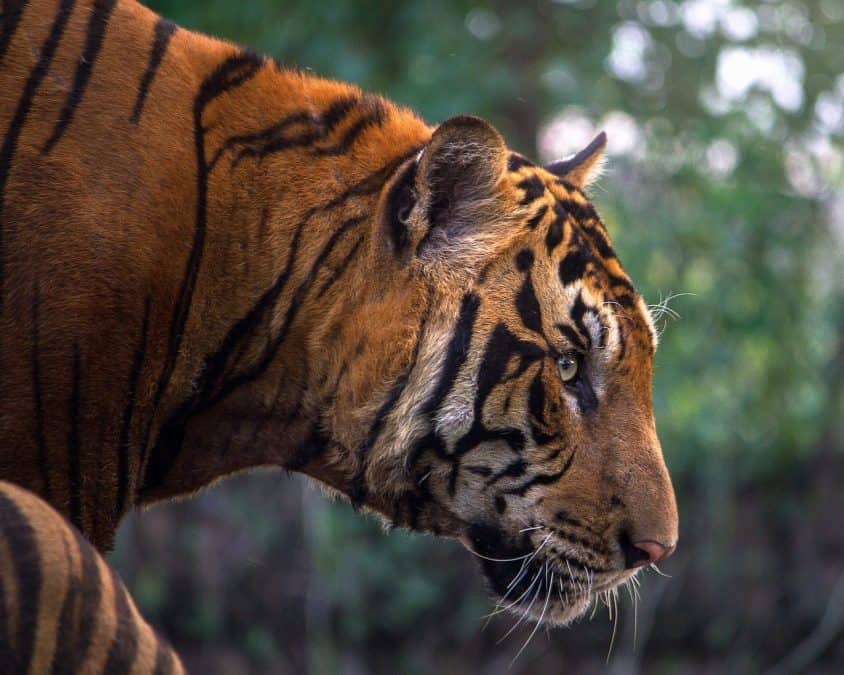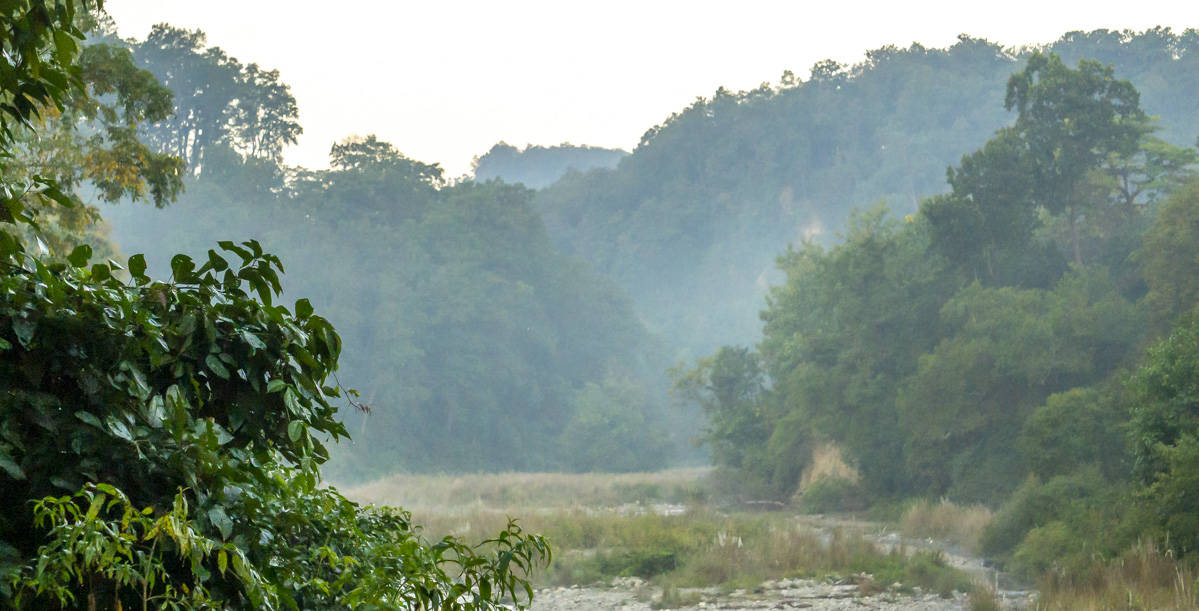This post may contain affiliate links. By clicking and making a purchase through the links, I earn a small commission at no extra cost to you. See my disclaimer for more information. This and display ads allow me to keep the site up to date and give back.
In all the Tiger King mania, I’ve been thinking a lot about these amazing animals. I knew the situation was bad, but I was shocked to find out that there are fewer tigers in the wild than in captivity in the United States (which is estimated to be between 5000-10,000). With such low numbers, are there still places left to see tigers in the wild?
At the beginning of the 19th century, there were over 100,000 tigers roaming across Asia. Those numbers have fallen by over 95%, and there are now less than 4,000 wild tigers left. There were once nine subspecies of tigers, but only six have survived the last century. One of these, the South China tiger, is virtually extinct as all the remaining are in captivity.
Seeing animals in the wild is one of my biggest motivations to travel, and I’ve been lucky enough to see a Royal Bengal tiger while in India. I was curious about the other remaining tiger subspecies and wanted to find out if there are still ethical opportunities to see them. This post looks at the five remaining wild tiger species, where they are, and ways that you can see them in the wild that support their conservation.
The Royal Bengal Tiger
Location: India, Nepal, Bhutan

The Royal Bengal tiger is the most abundant of all the tiger subspecies, although they are still under threat. The good news is, both India and Nepal have reported an increased number of tigers in recent years. If you are going to see any of the tiger species in the wild, the Royal Bengal tiger is your best shot.
Where to See Wild Tigers in India
India is home to the majority of the Royal Bengal Tiger population. Recent government estimates show that there are nearly 3,000 tigers, an increase of 33% since 2014. This is in large part to the government’s efforts to protect the species, with over 50 tiger reserves across the country.
While I was traveling in India, I had to take a chance (or two) at spotting this elusive species in the wild. Unlike my attempt at finding a leopard in Sri Lanka, I had much more success in India. There are 50 tiger reserves in India so I won’t list them all, but here are three that are well known for their chances of seeing wild tigers.

Panna National Park
I didn’t know about Panna National Park before coming to India, but while on my G Adventures tour, our guide asked us if we wanted to visit for a chance to see tigers. The safari started at 4 am, but I happily said yes.
Like most safaris, seeing a wild tiger takes a lot of patience and waiting. On the day of our safari, the rangers had reportedly seen a tiger in one area of the park, so we waited and waited for hours until the tiger finally came out… in a completely different section of the park. I was rife with disappointment, but as we were continuing driving through the park, a majestic pregnant tiger came out of nowhere.
It was a completely surreal moment. There were a few other jeeps in front of ours, so I didn’t get the best vantage point for photos, but at that moment I didn’t even care. I couldn’t believe what I seeing with my own eyes. After a few minutes, she crossed in front of one of the jeeps and went into the forest, disappearing just as quickly as she appeared. We also saw some other wildlife in the park, including snakes, monkeys, deer, and birds.

Panna national park has approximately 40 tigers in the park. Based on my experience, I would recommend trying a tiger safari if you find yourself in the area. Panna is in the state of Madhya Pradesh. It’s close to the Khajuraho temple complex, a UNESCO world heritage site famous for its erotic carvings. It’s one of the most interesting temples I visited while in India.
I have also heard Bandhavgarh national park and Lanha national park, which are both in Madhya Pradesh state, are good for spotting wild tigers.
Jim Corbett National Park

Jim Corbett National Park is in the state of Uttarakhand in Northern India near the gorgeous town of Nainital. The park launched project tiger in 1972, a special conservation project to conserve the tigers in the area. It has the highest amount of tigers in any reserve in India, but the time of year you visit will make a huge difference in your chances to see one.
I was in Nainital just a couple of weeks after visiting the Panna national park. High on my luck from my first tiger sighting, I booked a safari to go to Jim Corbett National Park. This once again involved waking up at 4 am, to get inside the park at the opening tour at 6:30 am. As we began chatting with the guide, he quickly told us that it’s very rare to see a tiger at this time, with only a 5-10% chance. My heart sunk. How could a park with such a good reputation for tiger sightings have such low odds? Well, it turns out some of the roads in Jim Corbett National Park get washed away during monsoon season and certain zones of the park don’t open again until mid-November. These are the zones where the tigers are.
Basically, I got scammed by a tour operator in Nainital who knew my chances to see a tiger would be almost nonexistent but sold me the safari anyway. Despite my bad experience, the guide told me there is a 90% chance of seeing tigers if you go during the right season. This would be between Mid-November and February when all the zones are open.

Ranthambore National Park
Ranthambore National Park is a wildlife reserve in the state of Rajasthan widely regarded as one of the best spots to see tigers in India. I didn’t get a chance to go there while I was in India, but this is the place I heard named again and again by locals for seeing tigers. Apparently the tigers there are so used to seeing tourists that they often just chill on the side of the road, so you don’t have to go looking far in the jungle. A friend I met in India shared this photo he took of a tiger in Ranthambore National Park!

Where to see Tigers in Nepal
Nepal has far fewer tigers then India (In 2015, the population was estimated to be about 163–253), but it’s also a much smaller country. There are two parks in Nepal popular for safaris: Chitwan National Park and Bardia National Parks.
I have been to Chitwan national park and did not see any tigers here, nor did I hear of anyone else spotting them. I also have mixed feelings about this park. It’s one of the best places in the world to see the greater one-horned Rhino and the park has done an incredible job of preserving that species. But, on the other hand, the park is still keeping elephants in captivity which I strongly disagree with.
Although more difficult to get to, Bardia National Park is considered one of the best places to see tigers in Nepal. All Bardia lodges offer walking and 4WD drive safaris in the park where you have a chance at spotting tigers, among other wildlife.
Where to see Tigers in Bhutan
Tiger safaris are in their infancy in Bhutan, and with just over 100 tigers, the chances of seeing one here are quite low, but not impossible. However, Bhutan is a remarkable country with a wealth of other wildlife and natural beauty, so an exploration into the jungle to search for tigers will not be disappointing. Choose a responsible tour operator and head into Jigme Singe Wanchuck National Park, where most of the tigers live.
Amur Tiger/Siberian Tiger

Location: Russia/China
The Amur Tiger, also known as the Siberian tiger, mainly lives in eastern Russia’s birch forest and their bordering reasons. According to the WWF, it is believed there are around 480-540 Siberian tigers left in the wild. While this might not seem like much, it’s incredible considering the species was on the brink of extinction with fewer than 40 left in the 1940s. The species was saved largely in part to Russia becoming the first country in the world to grant tiger protection.
The species is still under threat today, mainly from deforestation from lodging, as well as poachers who sell their parts in the illegal animal trade. But it’s not all bad news. The population has increased over the last decade, and in 2019, the Komissavorsky Wildlife Refuge was established in Russia’s Primorsky Region, which borders two protected areas in Northeastern China. These three areas provide a crucial space for the Siberian tiger and Siberian leopard, one of the most endangered species in the world.

With so few tigers in such a large area, it would be rare to see one in the wild. However, there is an opportunity to potentially see one while contributing to their conservation on this project/safari with Natural World Safaris. You would be venturing out each day with an expert conservationist Alexander Batalov, setting camera traps in search of the Siberian tigers. I participated in a similar conservation project in Malawi, and it was incredibly rewarding. Batalov also runs Russia Tiger Tracking, an eco-lodge dedicated to tiger tracking.
Malayan Tiger
Location: Malaysia/Thailand

With less than 200 remaining, the Malayan tiger is a critically endangered tiger subspecies that lives on the Malayan Peninsula in Southeast Asia. The population of the species has been declining, and biologists have warned the species will go extinct without drastic conservation efforts.
While you likely won’t see one in the wild, you can still get involved and help support the conservation of this species by joining a ‘CAT walk’ either in-person to virtually with the Citizen Action for Tigers (CAT) in Malaysia. CAT walks are anti-poaching, anti-deforestation walks guided by volunteers and locals at poaching hotspots around Malaysia’s largest national park, Taman Negara. This is a great way to support the conservation of tigers if you are visiting Malaysia!
Indochinese Tiger
Location: Thailand, Laos, Myanmar
Indochinese Tigers once roamed throughout Southeast Asia, but they have been hunted into extinction by poachers in most countries. Thailand still has 160 or so Indochinese tigers, and has just set up a tiger conservation center in the Huai Kha Khaeng Wildlife Sanctuary. Guided tours are available at the park, where you may have a chance at spotting the species.
Sumatran Tiger

Location: Indonesian island of Sumatra
The Sumatran tiger is classified as critically endangered, and the WWF estimates there are less than 400 left in the wild. They were once found across multiple parts of Indonesia, but are now all located on the small island of Sumatra.
Although the chances of seeing a Sumatran tiger in the wild are low, there are multi-night trekking expeditions that will take you into the jungle looking for them in Kerinci Seblat National Park. The Sumatran rain forest is rich in many other species including orangutans, rhinoceros, elephants, tapirs, sun bears, leopards, and many birds and butterflies, so the expedition will be amazing regardless.
Why you Should Avoid Interacting with Captive Tigers
Since it’s so difficult to see a tiger in the wild, it can be tempting to visit a tiger ‘sanctuary’ or even pay to cuddle with a tiger cub. Please do not do this, these tigers have horrific lives. Most are born in tiger mills where females churn out two to three litters a year, compared with one litter every two years in the wild. The cubs are pulled from the mother at birth, fed poorly, and then go to work at just a few weeks old where they are passed around up to 10 hours a day. At three or four months, they become too big and dangerous to pet and are often killed as they are no longer useful. Not to mention these attractions pose huge risks to public safety, and many tourists have been attacked in the past by captive tigers.
This type of attraction only exists because there is a demand for it from tourists. By supporting these businesses, you are supporting the suffering of these incredible animals. Instead, support the conservation of them by visiting a national park where you can watch them from a safe distance in the wild.
I hope this post could help you discover some places to see tigers in the wild! I know when it’s safe to travel again I’ll be heading back to Asia for some of these remarkable wildlife encounters.
Enjoyed this post? Pin it for later!




Hi Lora, You should visit Ranthambore (Rajasthan) and Bandhavgarh (Madhya Pradesh) if you want to see tigers in the wild. In Ranthambore, I spotted tiger in 5 out of 6 safaris. Tiger sightings are good in both national parks.
[…] was an unbelievable feeling to see a tiger within the wild for the primary time. We had been all so excited, standing up within the jeep to get the perfect […]
[…] was an incredible feeling to see a tiger in the wild for the first time. We were all so excited, standing up in the jeep to get the best view. It only […]
[…] was an incredible feeling to see a tiger in the wild for the first time. We were all so excited, standing up in the jeep to get the best view. It only […]